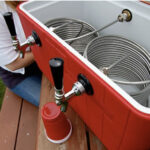Plastic injection molding is among the widely popular processes that one uses to manufacture quality and precise parts for various sectors such as medical, automotive, and toys. It is famous for its benefits, leading to a broad range of manufacturing processes for all industries.
There are several types of injection molding that many industries use, and it depends on the parts meant for production. Amongst the types accessible today, plastic insert molding and overmolding are amongst the two most common molding methods used. In this read, we will be discussing the difference between insert molding and overmolding so that you know which is better for you.
Insert Molding
Insert molding is adding metal parts for injection molded parts during the molding instead of curing the parts. Cutting down on post-molding operations. In this process, inserts are placed automatically or manually onto mold cores into the molds themselves.
After closing the mold halves, plastic pallets will be plasticized in the injector barrel and shot directly into the mold, the plastic material flowing around the captured inserts. This process usually consists of placing insert, part, or to the pin into the mold. The method includes injecting melted plastic into the mold for creating the encapsulated finished part.
This process is fast because it occurs in parallel or at the same time. When comparing it with other methods that need more than one shot, some examples can be a gear onto the metal shaft, metal guide pins into the plastic part. Also, the hooks are made of metal that may need a plastic retainer.
Process Of Insert Molding
Insert molding is the process of thermoplastic molding material around the performed component for creating a finished part incorporating multiple materials. The inserts are usually of metal parts best for reinforcing the mechanical properties of the plastic part.
The inserts go into the mold, and inject the thermoplastic within thethe mold to form the part when you compare it to installing inserts into the plastic part in a post-molding process.
The molded-inserts utilization will eliminate the requirement for secondary installation of the insert and reduce the costs. This process usually comes in handy in various industries such as medical, consumer products, automotive, and electronic components.
Benefits Of Insert Molding Over Traditional Injection Molding
The general use for the insert molding is to include more than one threaded metal inserts in the plastic part when that part is supposed to mate to another part in an assembly. Plastics alone may not have adequate properties that can withstand the forces needed to fasten two parts together.
For instance, threads in a plastic part can become worn over repeated usage, which results in a failed component. By using metal as the insert, it will drastically amplify the strength and ensure reliable fastening over continuous parts. This plastic and metal combination allows designers to benefit from the weight reduction of plastics and increases metal strength.
Overmolding
It is a process of adding an extra material layer over an already existing part or piece. This process is usually for manufacturing parts, sub-sections of parts, and prototype development. When the overmold materials become solid, the two materials will join together as a single part.
The materials cover the first material in the overmolding process. This process demands a solid plastic component to overlay it with a TPU layer or other materials using insert molding, known as the insert mold technique.
Overmolding cables are complete assemblies that combine the connector and wire into one single, seamless piece. To do this, the cable assembly will go within the mold. After that, molten plastic material will be injected into the cavity of the mold. After cooling the plastic, it conforms to the shape of the mold and encapsulates the junction point between the wire and connector.
Process Of Overmolding
An overmolding procedure includes machines or components created by joining more than one material into one mold. The used materials can either be of different or the same materials. The material combinations are endless.
To get a better idea of the process, you will need to understand the two components. Every molding project will break down into two parts. The initial process part is the substrate and the second part is the overmold.
The substrate is popular as the base material. It can be of any type. The overmold is the secondary material. It is something that you want to mold over the substrate. in most cases, there can be more than
Overmolding Applications
The administration of the overmolding is done for various reasons as it can help specify and execute a particular project. Standard materials such as toothbrushes, tool hand grips, and personal health care products such as shaving razors and shampoo bottles. Below are some of the examples of applications for overmolding.
● Plastic Over Plastic
Initially, mold the rigid substrate. After that, another plastic will be molded onto or around the substrate. The plastics differentiate in color or resin.
● Rubber Over Plastic
In this process, initially, the rigid plastic will be molded. After that, soft rubber or TPE will be molded onto or around the substrate. It provides a soft grip on the frozen part.
● Plastic Over Metal
This process requires machining, casting, or forming. The substrate will go into the injection molding tool, and the plastic will be molded onto the metal. It is usually for capturing the metal components in the plastic part.
● Rubber Over Metal
In this process, the mold is cast, formed, or machined. After that, it goes within the injection molding tool, and the rubber is molded around the metal. It provides a soft grip on the surface.
Conclusion
These are significant differences between overmolding and insert molding. Choosing the correct type of process depends on the work requirements and the industry you are working in. Moreover, you should always take your time and study about all the feasible ways and methods that you can choose for your work as it can help you to make informed-decisions.





